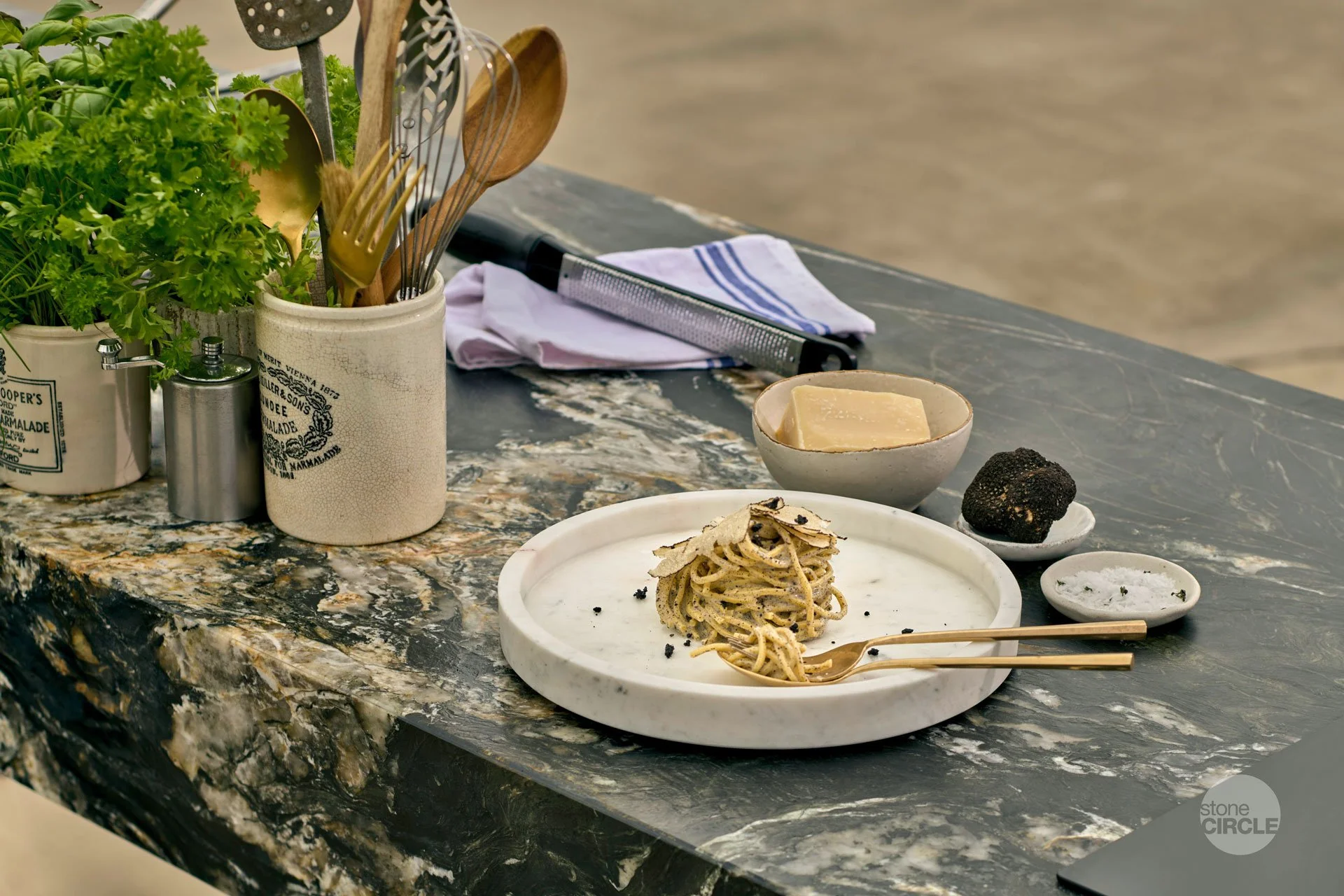Earthy Elegance: Colours Inspired by Nature
2025 Trends in Stone and Quartz (part 1)
As we enter 2025, the world of natural stone and quartz is brimming with exciting trends that balance timeless elegance and contemporary innovation. Whether planning a private residential renovation or designing for luxury retail and hospitality spaces, these trends will inspire and elevate your projects.
Nature’s palette continues to influence choices of stone and quartz. Expect to see warm, earthy tones dominate alongside bold contrasts that add personality to spaces.
Let’s take a look at the colours, textures, and design directions shaping the year ahead.
Rich Neutrals: A Timeless Foundation for Modern Spaces
Shades like taupe, sand, and warm beige continue to dominate design palettes in 2025, bringing a soothing, natural warmth to interiors. These tones are celebrated for their ability to create calm, inviting spaces while offering incredible versatility that transcends fleeting trends.
Moleanos limestone
Palmyra limestone
Natural warm-toned stones, such as Moleanos or Palmyra limestones, embody this trend perfectly. Their soft, earthy hues provide the ideal backdrop for a wide range of design aesthetics, from minimal and contemporary to classic and traditional.
Applications
Flooring: Rich neutrals like Moleanos or Palmyra limestone add an understated elegance and a natural glow to floors, pairing beautifully with wooden cabinetry and sleek, modern finishes.
Bathroom Vanities: Neutral tones bring serenity to bathrooms, especially when paired with soft lighting and metallic fixtures. The subtle texture of limestone enhances the spa-like atmosphere designers and homeowners seek.
Statement Walls: Beige limestone slabs or tiles are perfect for creating striking yet tranquil feature walls in living rooms, hallways, or offices, balancing sophistication with warmth.
For projects seeking a harmonious blend of functionality and style, rich neutral tones offer a timeless foundation that enables other design elements—bold or subtle—to stand out. Whether working on a residential retreat or a luxurious hospitality setting, these hues will enhance your space.
Check Moleanos and Palmyra on our stone library:
Deep Greens and Charcoal Hues: Drama and Sophistication in Design
In 2025, darker tones like deep greens and charcoal hues are at the forefront of design, offering a bold yet elegant way to add depth and drama to interiors. These rich, moody shades are inspired by nature, evoking the lush vibrancy of forests and the rugged strength of stone-covered landscapes. Thus, they are ideal for projects combining natural beauty with contemporary sophistication.
Verde Alpi, green marble from Italy
Belvedere Vintage, dark grey quartzite from Angola
Materials like Verde Alpi marble, with its striking green tones and intricate white veining, or Belvedere Vintage, a deep charcoal quartzite with subtle patterns and a luxurious leather finish, are perfect examples of how these colours bring timeless elegance to any space.
Applications
Feature Countertops and Kitchen Islands: A dark green or charcoal-toned surface instantly becomes the focal point of a room. These materials, paired with lighter cabinetry or metallic accents like brass or brushed gold, add a high-end, tailored look to kitchens.
Bathroom Statements: Verde Alpi marble creates a spa-like ambience, especially when used for statement walls, shower enclosures, or floating vanities. Its connection to nature makes it a natural fit for calming yet dramatic bathroom spaces.
Fireplace Surrounds and Feature Walls: Deep greens and charcoals work beautifully as the backdrop for feature walls or fireplace surrounds. When paired with neutral furnishings and soft lighting, the darker tones create a striking contrast, adding layers of visual interest.
Furniture and Decorative Accents: Charcoal-hued granite or quartzite like Belvedere Vintage are used in custom furniture designs, such as side tables, shelving, and statement dining tables. Their subtle patterns and durable finishes ensure both beauty and practicality.
Pairing for Contrast
Darker tones like these shine brightest when paired with contrasting materials and finishes. Combine deep greens with light beige, cream, or white marble to create a classic yet fresh contrast, or add warmth with wooden cabinetry and flooring. Metallics—such as bronze, gold, or aged brass—enhance the sophistication of these dark tones, creating a genuinely luxurious aesthetic.
Whether you’re designing a private retreat or a high-end retail space, deep greens and charcoals bring a sense of grounded elegance and bold personality to interiors. These tones connect us to the raw beauty of nature while delivering a contemporary edge that’s anything but ordinary.
Check Verde Alpi and Belvedere Vintage on our stone library:
Soft Veining in Pastels: Understated Elegance for Minimalist Designs
In 2025, subtle pastel veining is a key trend for those seeking a refined, understated interior look. This delicate design approach enhances the natural beauty of stone and quartz without overwhelming the space, making it a favourite for minimalist aesthetics. Shades like soft blush pink, muted sage green, and pale lavender add a whisper of colour that feels fresh, modern, and effortlessly sophisticated.
Alba Chiara, pink marble from Turkey
Ming Green, green marble from China
Materials such as Alba Chiara marble, with its faint blush tones, and the calming sage hues of Ming Green marble are perfect examples of how pastel veining can bring a gentle, organic warmth to contemporary spaces.
Applications
Kitchen Countertops and Backsplashes: Softly veined pastel quartz or marble works beautifully in minimalist kitchens, where clean lines and uncluttered spaces allow the subtle colours to take centre stage. The barely-there hues pair well with neutral cabinetry, such as matte white or light wood, creating a timeless and serene environment.
Bathroom Surfaces: Pastel-toned veining is ideal for bathrooms, where light and soft colours enhance tranquillity. Use it for vanities, shower walls, or tiles to create a spa-like retreat that feels calming and luxurious.
Accent Features: For a touch of colour without overwhelming the space, consider using soft-veined pastel stone or quartz for minor design elements such as windowsills, shelves, or table tops. This adds a subtle charm and interest to any room.
Pairing Pastels with Other Elements
Pastel-veined surfaces shine when paired with neutral tones like ivory, beige, or dove grey, but they also work well with contrasting materials. Combine them with brushed gold or rose gold metallic fixtures to highlight the warmth of blush tones, or pair them with dark matte finishes for a modern, high-contrast look.
For a nature-inspired aesthetic, soft greens like those in Ming Green marble can be complemented by natural wood finishes or rattan accents, evoking a biophilic design that connects the indoors with the outdoors.
A Minimalist’s Dream
Soft pastel veining brings a unique balance to minimalist design, combining simplicity with a touch of personality. Its subtlety ensures that the stone or quartz integrates seamlessly into a space without overpowering other elements. The result is an effortlessly elegant and calming environment—perfect for residential projects, boutique hospitality spaces, or luxury retail interiors.
Check Alba Chiara and Ming Green on our stone library:







